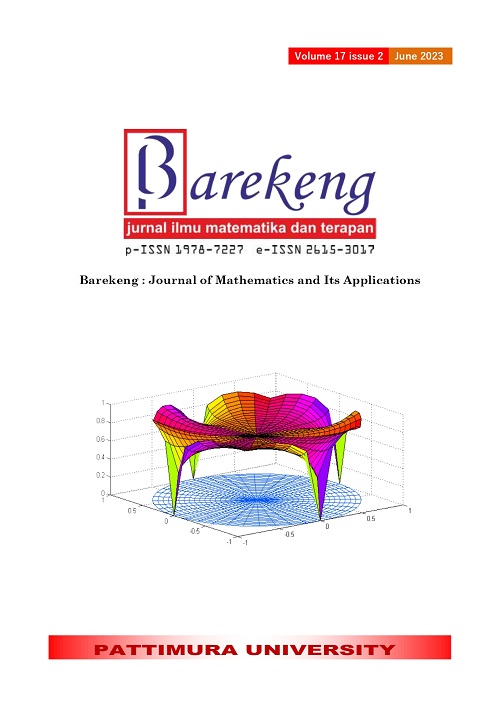COMPARISON OF DOUBLE RANDOM FOREST AND LONG SHORT-TERM MEMORY METHODS FOR ANALYZING ECONOMIC INDICATOR DATA
Abstract
The performance of machine learning in analyzing time series data is being widely discussed. A new ensemble method Double Random Forest (DRF), which considers supervised learning currently developed. This method has been claimed to be able to improve the performance of Random Forest (RF) if the data is under-fitting. Another machine learning method, Long Short-Term Memory Networks (LSTMs) have capability to analyze nonlinear data. Since the study compare both methods has not been existed in literature, it is interesting to compare the performance of both methods using Indonesian data, especially economic indicator data which have been found to be under-fitting, non-underfitting, and nonlinear data. The indicators used in this study are Export, Import, Official Reserves Asset, and Exchange Rate data. The results showed that overall, the LSTMs method outperforms DRF method in analyzing the data.
Downloads
References
M. Larrea, A. Porto, E. Irigoyen, A. J. Barragán, and J. M. Andújar, “Extreme learning machine ensemble model for time series forecasting boosted by PSO: Application to an electric consumption problem,” Neurocomputing, vol. 452, pp. 465–472, 2021.
V. Plakandaras, T. Papadimitriou, and P. Gogas, “Forecasting the USD / EUR daily and monthly rate with machine learning techniques,” J. Forecast., vol. 34, pp. 560–573, 2015.
C. Katris, “A time series-based statistical approach for outbreak spread forecasting: Application of COVID-19 in Greece,” Expert Systems with Applications, vol. 166, 2021.
M. Khalil, A. S. McGough, Z. Pourmirza, M. Pazhoohesh, and S. Walker, “Machine Learning, Deep Learning and Statistical Analysis for forecasting building energy consumption — A systematic review,” Eng. Appl. Artif. Intell., vol. 115, 2022.
S. I. Busari and T. K. Samson, “Modelling and forecasting new cases of Covid-19 in Nigeria: Comparison of regression, ARIMA and machine learning models,” Scientific African, vol. 18, 2022.
L. N. A. Mualifah, A. M. Soleh, and K. A. Notodiputro, “A comparative study of GARCH, LSTM, and HYBRID GARCH–LSTM models for analyzing the dynamical pattern of stock price volatility,” Master Thesis, IPB University, Bogor, West Java, Indonesia, 2022.
E. H. A. Rady, H. Fawzy, and A. M. A. Fattah, “Time series forecasting using tree based methods,” J. Stat. Appl. Probab., vol. 10, no. 1, pp. 229–244, 2021.
S. Han, H. Kim, and Y. S. Lee, “Double random forest,” Mach. Learn., vol. 109, no. 8, pp. 1569–1586, 2020.
A. H. Elsheikh, V. P. Katekar, O. L. Muskens, S. S. Deshmukh, M. A. Elaziz, and S. M. Dabour, “Utilization of LSTM neural network for water production forecasting of a stepped solar still with a corrugated absorber plate,” Process Safety and Environmental Protection, vol. 148, pp. 273–282, 2021.
M. Marzouk, N. Elshaboury, A. A. Latif, and S. Azab, “Deep learning model for forecasting COVID-19 outbreak in Egypt,” Process Safety and Environmental Protection, vol. 153, pp. 363–375, 2021.
I. Nasirtafreshi, “Forecasting cryptocurrency prices using Recurrent Neural Network and Long Short-term Memory,” Data Knowl. Eng., vol. 139, 2022.
R. Supakar, P. Satvaya, and P. Chakrabarti, “A deep learning based model using RNN-LSTM for the Detection of Schizophrenia from EEG data,” Computers in Biology and Medicine, vol. 151, 2022.
M.A Ganaie, Hu. Minghui, A.K. Malik, M. Tanveer, and P.N. Suganthan, “Ensemble deep learning: A review,” Eng. Appl. Artif. Intell., vol.115, 2022.
C. Olah, “Understanding LSTM Networks,” 27 August 2015, [Online]. Address: https://colah.github.io/posts/2015-08-Understanding-LSTMs/ (Accessed 16 November 2022).
S. D. Khan, L. Alarabi, and S. Basalamah, “Toward smart lockdown: A novel approach for covid-19 hotspots prediction using a deep hybrid neural network,” Computers, vol. 9, no. 4, pp. 1–16, 2020.
H. Abbasimehr, M. Shabani, and M. Yousefi, “An optimized model using LSTM network for demand forecasting,” Comput. Ind. Eng., vol. 143, 2020.
Z. Yan, J. Wang, L. Sheng, and Z. Yang, “An effective compression algorithm for real-time transmission data using predictive coding with mixed models of LSTM and XGBoost,” Neurocomputing, vol. 462. pp. 247–259, 2021.
W. Zha, Y. Liu, Y. Wan, R. Luo, D. Li, S. Yang, and Y. Xu, “Forecasting monthly gas field production based on the CNN-LSTM model,” Energy, vol. 260, 2022.
Y. Ensafi, S. H. Amin, G. Zhang, and B. Shah, “Time-series forecasting of seasonal items sales using machine learning – A comparative analysis,” International Journal of Information Management Data Insights, vol. 2, no. 1, 2022.
J. J. Montaño Moreno, A. Palmer Pol, A. Sesé Abad, and B. Cajal Blasco, “Using the R-MAPE index as a resistant measure of forecast accuracy,” Psicothema, vol. 25, no. 4, pp. 500–506, 2013.
S. X. Lv, L. Peng, H. Hu, and L. Wang, “Effective machine learning model combination based on selective ensemble strategy for time series forecasting,” Inf. Sci., vol. 612, pp. 994–1023, 2022.
Copyright (c) 2023 Andika Putri Ratnasari, Budi Susetyo, Khairil Anwar Notodiputro

This work is licensed under a Creative Commons Attribution-ShareAlike 4.0 International License.
Authors who publish with this Journal agree to the following terms:
- Author retain copyright and grant the journal right of first publication with the work simultaneously licensed under a creative commons attribution license that allow others to share the work within an acknowledgement of the work’s authorship and initial publication of this journal.
- Authors are able to enter into separate, additional contractual arrangement for the non-exclusive distribution of the journal’s published version of the work (e.g. acknowledgement of its initial publication in this journal).
- Authors are permitted and encouraged to post their work online (e.g. in institutional repositories or on their websites) prior to and during the submission process, as it can lead to productive exchanges, as well as earlier and greater citation of published works.






1.gif)



